Like many fascinated by history and fashion, I often find myself captivated by the elegance of Victorian gowns, dreaming of layers of fabric, rich colors, delicate ribbons, and the overall refinement that defines the era. Being deeply rooted in the Southwest – an Arizona native with ties to the Daughters of Utah Pioneers and now residing in Denver – this fascination has naturally led me to explore pioneer clothing. Specifically, I’ve become intrigued by how the practicalities of the Western frontier shaped women’s fashion compared to the established styles of Eastern cities during the same period, particularly when it came to Pioneer Woman Dresses.
Pioneer women faced a unique set of considerations when building their wardrobes. From the need for practicality and durability to maintaining a sense of decorum and personal style, their clothing choices were a fascinating blend of necessity and aspiration. In this exploration, we’ll uncover the essential elements of their everyday attire and delve into the world of pioneer woman dresses, from the foundational undergarments to the fabrics and styles that defined their lives on the frontier.
Defining Pioneer Dresses: Fashion on the Western Frontier
For our exploration of pioneer woman dresses, we’ll focus on the period roughly between 1850 and 1890, west of the Missouri and Arkansas borders. The styles and wardrobes we’ll be discussing primarily belong to women who were homesteaders and part of settlement communities. It’s important to note that this discussion mainly centers on the experiences of white settlers migrating westward from the East.
What truly fascinates me about pioneer woman dresses is that their design was less about social status or purchasing power, and more about the shared experience of families pursuing their dreams in the uncharted West. Clothing became a reflection of resilience, adaptation, and a common bond among these pioneering communities.
The Foundation: Undergarments Worn Under Pioneer Dresses
Interestingly, the undergarments worn beneath pioneer woman dresses weren’t drastically different from those fashionable in Eastern cities. The chemise, a light cotton slip, remained a fundamental piece, primarily worn for hygiene and regularly laundered. Pantalets, made of flannel or cotton, followed, serving purposes of modesty, as underwear in the modern sense was not yet common.
Contrary to initial assumptions, most frontier women included a corset in their wardrobes to wear under their pioneer woman dresses. Many women venturing west were driven by hopes for a better future for their families, whether for economic opportunity or religious freedom. These were “proper” women who valued maintaining societal norms, and the corset was considered an essential garment of the time.
While women engaged in strenuous physical labor might have loosened or even forgone their corsets during household tasks, the majority of women on the frontier brought corsets and wore them as often as possible under their pioneer woman dresses.
Following the corset came petticoats, often multiple layers to adjust for formality or weather conditions, influencing the shape and fullness of the pioneer woman dresses worn over them. Stockings were essential when leaving the house or receiving visitors, typically held up by garters or tucked into pantalets – a detail that might seem rather uncomfortable today!
Fabrics of Choice for Pioneer Dresses
Calico was the undisputed fabric of choice for everyday pioneer dresses. Often envisioned as quaint floral prints, calico is actually a type of plain-woven cotton fabric, slightly lighter than modern canvas. Its qualities made it ideal for the frontier environment: lightweight, durable, and easy to clean, perfectly suited for the active lives of pioneer women. General stores offered calico in various dyed options, but women also frequently dyed fabric themselves using commercially available dyes or natural pigments derived from plants like leaves, bark, berries, and fruits.
For “Sunday best” pioneer dresses and more formal occasions, cotton and silk fabrics were still favored. Many women brought finer dresses made of these materials with them as they moved West, intending to maintain a sense of occasion when possible.
While fabrics were available at general stores, accessibility varied greatly depending on location. In more remote areas, families often had to produce their own fabrics, a complex process that deserves a separate discussion.
Daily Pioneer Dresses: Practicality Meets Style
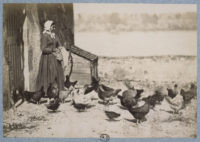 Pioneer woman in daily wear
Pioneer woman in daily wear
Regardless of their backgrounds in the East, women in frontier settlements were essential contributors to the establishment and upkeep of homes and farms. Their days were filled with cooking, cleaning, childcare, laundry, and often fieldwork – not to mention, the ever-present baking! The success of family farms and ventures relied on everyone’s physical labor, with no room for outsourcing domestic tasks. Pioneer women quickly adapted to a life of manual work, and their pioneer dresses needed to reflect this reality.
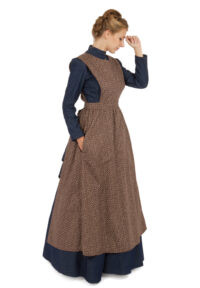 Pioneer Calico Apron
Pioneer Calico Apron
The general dress styles popular nationwide – fitted bodices and full skirts – were adopted for pioneer dresses, but with key modifications for frontier living. Skirts for everyday pioneer dresses were hemmed approximately three inches shorter, making movement easier for daily chores. Weights were sometimes sewn into the hems to prevent skirts from blowing up in windy conditions, a practical consideration in the open landscapes of the West.
While bodices remained fitted, sleeves on daily pioneer dresses were typically looser and extended to the wrists, paired with high collars for sun protection. These adaptations made pioneer dresses more practical for outdoor work and the frontier climate.
Laundering clothing was a significant task, especially for the often-used daily pioneer dresses. The concept of “wash dresses” emerged to address this. As noted in How the West Was Worn by Chris Enss, a popular “wash dress” style in 1867 featured a two-piece design in white cotton with a printed background. Its easy-care nature made it widely adopted across socioeconomic levels and quickly replicated by seamstresses throughout the West. This “wash dress” exemplifies how fashion adapted to the practical needs of frontier life and the demands placed on pioneer woman dresses.
Sunday Best Pioneer Dresses: Maintaining Tradition and Community
 Frontier couple dressed for church
Frontier couple dressed for church
Even in sparsely populated areas, settlements often formed communities with churches at their center. Church attendance was a strong social norm. While accounts exist of women in impoverished communities attending church barefoot, it was more common for women to have at least one or two pioneer dresses specifically reserved for Sundays. However, historical records often focus on more privileged settlers, so the full spectrum of experiences is difficult to ascertain.
“Sunday best” pioneer dresses closely mirrored fashionable styles in Eastern cities. Full skirts, worn over petticoats and corsets, were standard. Sleeve styles of the time, such as bell, leg-o’-mutton, or pagoda sleeves, were also incorporated into these more formal pioneer dresses. Skirt styles followed current trends, whether crinoline, hoop, or bustle, depending on the decade.
Color choices for Sunday pioneer dresses reflected social conventions. Younger women and newlyweds favored lighter colors, transitioning to darker shades as they aged. These dresses were completed with the most fashionable hats available, along with kid gloves and low-heeled boots, demonstrating a commitment to maintaining fashionable dress even on the frontier.
Social Pioneer Dresses: For Roundups, Balls, and Community Gatherings
For women with the means, a separate category of pioneer dresses existed for social events. Dances, holiday celebrations, picnics, and other community gatherings were common, and mirroring Eastern customs, women dressed for these occasions.
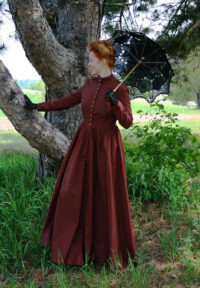 Woman in an Americana Victorian Cotton Dress
Woman in an Americana Victorian Cotton Dress
These social pioneer dresses were highly valued. Women might order fabrics from general stores and eagerly await the chance to create the latest styles. Godey’s Ladies Book was widely circulated and influential, with frontier women enthusiastically copying dress patterns and styles from its pages. This publication served as a vital link to fashion trends for women in remote areas, influencing the design of their social pioneer dresses.
Fabric availability for these dresses depended heavily on the proximity to towns and general stores. In many cases, women had a limited number of dresses, so their “best” dress served for both church and social events. Embellishments like hand-crocheted collars and shawls were used to elevate these dresses for different occasions, highlighting the resourcefulness of pioneer women in adapting their wardrobes.
Accessorizing Pioneer Dresses: The Finishing Touches
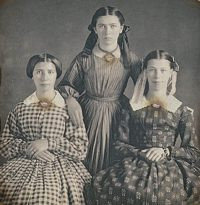 Pioneer girls with accessories
Pioneer girls with accessories
Accessories played a surprisingly significant role in the frontier wardrobe, adding personality and refinement to even the simplest pioneer dresses. Beyond hoop skirts and calico, the finishing touches were crucial. Jewelry and accessories were highly valued and frequently mentioned in historical accounts.
Women on the frontier accessorized their pioneer dresses with:
- Aprons
- Boots
- Brooches
- Lockets
- Earrings
- Precious stones and metals
- Hair adornments
- Hats
- Collars and cuffs
- Gloves
- Undersleeves
- Parasols
- Fans
- Handbags
- Shawls
These accessories allowed pioneer women to express individuality and elevate their pioneer dresses, even with limited resources, showcasing their enduring desire for beauty and personal style.
The Lasting Legacy of Pioneer Woman Dresses
My growing interest in my own pioneer ancestors has fueled my fascination with this topic. While “prairie style,” “pioneer,” and “western wear” clothing are readily available today, delving into the historical context of how women in this era balanced propriety, beauty, and fashion amidst the demands of frontier life reveals a compelling story. The evolution of pioneer woman dresses reflects adaptation, resilience, and a persistent connection to fashion ideals even in the face of challenging circumstances.
The story of pioneer woman dresses is one of enduring style shaped by necessity and circumstance, leaving a rich legacy that continues to inspire fashion and historical interest today.
Create Your Own Pioneer Dress Inspired Look:
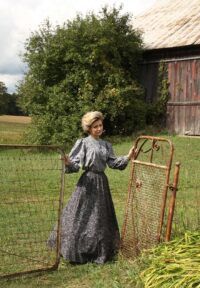 Woman in pioneer clothing in a field
Woman in pioneer clothing in a field
Pioneer Calico Blouse and Skirt
Browse our entire pioneer clothing collection
Pioneer Calico Blouse and Skirt
Harper Victorian Pioneer Dress
Pioneer Blouse, Apron and Skirt
